Sheikh Zayed Grand Mosque
Visiting the Sheikh Zayed Grand Mosque in Abu Dhabi is not like visiting any other religious building that I am aware of. Certainly it was very different from either of the other two enormous mosques we visited, Sohar and Muscat. In Sohar we just walked in, the only visitors during the non-Muslim visiting hours, and could have walked around basically unnoticed if we hadn’t specifically sought out someone to confirm that it was OK to go in all the places it seemed were basically left open for you to go in. In Muscat there was a main tourist gate, with a lobby area that had clothing available to rent or buy, and then after that you could wander where you wanted everywhere except the prayer hall, which had cordoned off walking areas for tourists around the hall.
In Abu Dhabi, the visit starts by reserving an entrance time. When you drive into the complex, you park in an underground lot that looks like it belongs to a shopping mall, because it does belong to a shopping mall. There’s a shopping mall in the mosque complex. After buying any necessary clothing– the dress code is the same as any other mosque, though signs at the entrance also specify a list of other forbidden things, such as teddy bears, suntanning, kissing, and a list of forbidden gestures that does not include the most common North American obscene hand sign– you proceed through a sort of airport security area with metal detectors, and then an even more airport-like corridor with a moving sidewalk and enormous photos of all of the political and religious leaders who have visited the space. Or you can take a taxi down the hallway!

Probably not the best idea to choose pictograms that can be deprecated…
After passing the fresh squeezed orange juice machine (?) you exit into the courtyard of the mosque proper, which has very specific areas where you can and cannot take photos.

The first “photo stop”
And finally, what we’ve been waiting for… the largest carpet in the world!




There was a sort of tourist path laid out, with the way through the prayer hall on a raised plastic surface so that you don’t have to take your shoes off. After reaching what seemed to be the final destination of that path, there were still signs that seemed to indicate you could go other places on the enormous grounds; specifically, we decided to try to see the women’s prayer hall– the above hall, of course, is only for men– and also the mausoleum of Zayed bin Sultan Al Nahyan, who ordered the mosque built, died during its construction, and was buried on the grounds.
We were intercepted on our way to the mausoleum by a security guard who said yes, we could go those places, but he would call us a taxi. So we took the buggy to the mausoleum; nobody else was there besides another guard enforcing the no-photos policy of it. Interestingly, the mausoleum was noticeably simple: inside a huge marble enclosure, the founder is buried in a raised box open on the top, so what you see is the pile of dirt on his corpse.
Then we went over to the women’s prayer hall, which a previous security guard had said only women are allowed to enter. (This wasn’t the case in Sohar or Muscat.) So I went up to the security guard outside that room, and asked if I could go in. “For the prayer?” she asked, looking at me like I was insane, since it was 9:45 in the morning. I said no, just to look, and at first she seemed to be saying no, but as I was about to leave she said yes and indicated a separate room to leave my shoes in and again, no photos of the room.
Maybe it was just the contrast with the insane opulence of the rest of the place, but even compared to the two other major mosques we visited, the womens’ room seemed, well, a little neglected? There was a carpet, and an intricate design on the ceiling, but in context it seemed to be making a clear statement that that this was not a place of major importance to, well, anyone of major importance.
Then we took the taxi back through the tourist corridor, and ended our visit at… the mosque mall Tim Hortons.